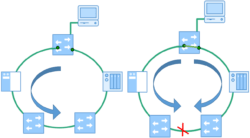PROFINET offers a variety of possible topologies: tree, line, ring, star, etc. Nearly all PROFINET devices have two ports on them, and behind these two ports, there is an integrated switch which allows the creation of a line topology. Some topologies permit redundant media and decrease the chance of failure. Specifically, PROFINET allows you to create network media redundancy with a ring topology. First, Ethernet should never be connected in a ring without being managed. Packets may go in circles infinitely and many issues can arise. PROFINET offers a solution by managing a ring topology with two defined media redundancy classes: Media Redundancy Protocol (MRP) and Media Redundancy for Planned Duplication (MRPD) or ‘bumpless’ redundancy.
MRP – Media Redundancy Protocol
In a ring topology, each device has two paths for data exchange. Taking a closer look, the topology is not really a closed ring (but a line). As shown in the diagram, a managed switch with the MRP feature manages the network. This MRP manager sends test frames around the ring constantly to verify the network. If the manager does not receive the test frame back it is a sign of network failure. The manager then alerts all clients and modifies the topology by closing the ring and creating a line topology. The recovery time is a few milliseconds.
MRPD – Media Redundancy for Planned Duplication
MRPD goes even further with no recovery time. MRPD is usually used with PROFINET Isochronous Real Time (IRT) and ensures non-stop connectivity. Each device sends two equal data frames to the receiver in opposite directions (two-way transmission). In case of a network failure, one frame will still arrive at the receiver. Watch this short video on Media Redundancy from our MinuteProfinet channel to visualize MRP and MRDP.
Read the full white paper on unmanaged and managed switches for PROFINET:
-Nelly Ayllon

